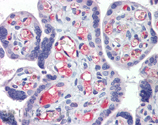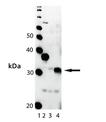Product Details
| Alternative Name: | HMOX1, Hsp32, Heat shock protein 32, Heme oxygenase 1 |
| |
| Host: | Rabbit |
| |
| Immunogen: | Native rat HO-1. |
| |
| UniProt ID: | P06762 |
| |
| GenBank ID: | J02722 |
| |
| Source: | Purified from rabbit serum. |
| |
| Species reactivity: | Human, Mouse, Rat
|
| |
| Applications: | IHC (PS), WB
|
| |
| Recommended Dilutions/Conditions: | Western Blot (1:1,000, ECL)
Suggested dilutions/conditions may not be available for all applications.
Optimal conditions must be determined individually for each application. |
| |
| Application Notes: | Detects a band of ~32kDa by Western blot. |
| |
| Purity Detail: | Protein A affinity purified. |
| |
| Formulation: | Liquid. In PBS, pH 7.2, containing 50% glycerol and 0.09% sodium azide. |
| |
| Shipping: | Blue Ice |
| |
| Long Term Storage: | -20°C |
| |
| Scientific Background: | Heme Oxygenase-1 (HO-1) also known as Hsp32, is the inducible isoform of heme oxygenase that catalyzes the NADPH, oxygen, and cytochrome P450 reductase dependent oxidation of heme to carbon monoxide, ferrous iron and biliverdin which is rapidly reduced to bilirubin. These products of the HO reaction have important physiological effects: carbon monoxide is a potent vasodilator and has been implicated to be a physiological regulator of cGMP and vascular tone; biliverdin and its product bilirubin are potent antioxidants; "free" iron increases oxidative stress and regulates the expression of many mRNAs (e.g., DCT-1, ferritin and transferring receptor) by affecting the conformation of iron regulatory protein (IRP)-1 and its binding to iron regulatory elements (IREs) in the 5'- or 3'- UTRs of the mRNAs. To date, three identified heme oxygenase isoforms are part of the HO system that catalyze heme into biliverdin and carbon monoxide. These are inducible HO-1 or Hsp32, constitutive HO-2 that is abundant in the brain and testis, and HO-3 which is related to HO-2 but is the product of a different gene. The HO system is the rate-limiting step in heme degradation and HO activity decreases the levels of heme which is a well known potent catalyst of lipid peroxidation and oxygen radical formation. |
| |
| Regulatory Status: | RUO - Research Use Only |
| |

Western blot analysis of HO-1, pAb (Prod. No. ADI-OSA-150): Lane 1: MW Marker, Lane 2: Human Liver Microsomes, Lane 3: Mouse Liver Microsomes, Lane 4: Rat Liver Microsomes

Immunohistochemistry analysis of human placenta tissue stained with HO-1, pAb at 10µg/ml.
Please mouse over
Product Literature References
Concurrent stimulation of monocytes with CSF1 and polarizing cytokines reveals phenotypic and functional differences with classical polarized macrophages: L. An, et al.; J. Leukoc. Biol.
112, 437 (2022),
Abstract;
Novel Role of Mammalian Cell Senescence-Sustenance of Muscle Larvae of Trichinella spp: M. Dabrowska, et al.; Oxid. Med. Cell. Longev.
2022, 1799839 (2022),
Abstract;
Resveratrol Protects Against Hydroquinone-Induced Oxidative Threat in Retinal Pigment Epithelial Cells: S. Neal, et al.; Invest. Ophthalmol. Vis. Sci.
61, 32 (2020),
Abstract;
Full Text
eIF2α phosphorylation is required to prevent hepatocyte death and liver fibrosis in mice challenged with a high fructose diet: W.G. Choi, et al.; Nutr.
14, 48 (2017),
Abstract;
Full Text
DHA sensitizes FaO cells to tert-BHP-induced oxidative effects. Protective role of EGCG: A. Fernandez-Iglesias, et al.; Food Chem. Toxicol.
62, 750 (2013),
Abstract;
Nordihydroguaiaretic acid activates the antioxidant pathway Nrf2/HO-1and protects cerebellar granule neurons against oxidative stress: J. Pedraza-Chaverri, et al. ; Neurosci. Lett.
447, 167 (2008),
Application(s): WB using rat cell lysates,
Abstract;
Hemoglobin scavenger receptor CD163 mediates interleukin-10 release and heme oxygenase-1 synthesis: antiinflammatory monocyte-macrophage responses in vitro, in resolving skin blisters in vivo, and after cardiopulmonary bypass surgery: R.C. Landis, et al. ; Circ. Res.
94, 119 (2004),
Application(s): WB using human cell lysates,
Abstract;
Related Products














